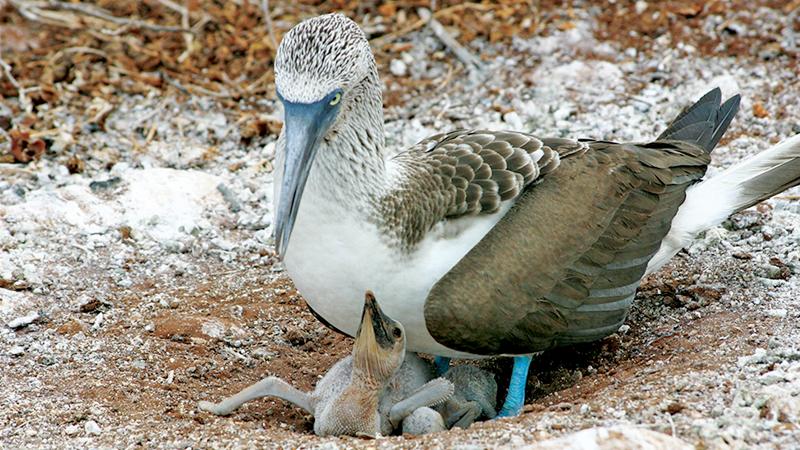
The blue-footed booby is one of the most iconic birds in the Islands, but after locals noticed their population declining.
Blue-footed boobies are one of three booby species found on Galapagos. They are large, distinctive birds, found along the Eastern Pacific coastline where they often nest on small islands with rocky coasts. Their name comes from the Spanish word ‘bobo’, meaning foolish or clown – referring to their clumsy movement on land. Their plumage is brown on top, with a white rump and black tail, whilst their underparts are white. The most distinctive characteristic of the blue-footed booby is its large blue feet, which play an important role in courtship. Females are thought to select males with brighter feet, as they are an indicator of his overall condition and thus the quality of his genes. Females tend to be larger than males, and have darker blue feet.
 Despite their clumsiness on land, boobies are extremely agile in the air. At dawn, they take to the sky in search of schools of small fish such as anchovies and sardines, often foraging in large groups of up to 200 birds. Once the prey has been spotted, the booby folds back its wings, giving it a more streamlined shape, and plunges into the water. Dives may occur from over 20 metres above the water, and the bird hits the water at speeds up to 60 mph, snapping up fish in its serrated beak.
Despite their clumsiness on land, boobies are extremely agile in the air. At dawn, they take to the sky in search of schools of small fish such as anchovies and sardines, often foraging in large groups of up to 200 birds. Once the prey has been spotted, the booby folds back its wings, giving it a more streamlined shape, and plunges into the water. Dives may occur from over 20 metres above the water, and the bird hits the water at speeds up to 60 mph, snapping up fish in its serrated beak.
The mating season for blue-footed boobies occurs between June and August. Mating is preceded by an elaborate courtship ritual, which begins with the male presenting the female with a small stick or stone. He then tips his beak, tail, and wing tips to the sky, whistles, and marches around the female with a high-stepping motion, showing off his feet. Once a match is made, the pair will often remain together for life. The female lays two to three eggs, which both parents take turns to incubate whilst the other keeps watch for predators. Boobies lack a brood patch, instead using their large feet to keep the eggs warm. Eggs hatch after approximately 45 days, and the chicks are fed on regurgitated fish by both parents. Young boobies will stay with their parents for about two months.
In Galapagos
Where to see them: North Seymour is one of the Galapagos’ best seabird breeding grounds, with blue-footed boobies occurring at high frequency. Large breeding populations can also be found on many other islands south of the equator – including Espanola, Fernandina, Floreana, Isabela, Pinzon, and Santa Cruz.
When to see them: Boobies tend to spend most of their time at sea outside the mating season, so the best time to see them close up on land is when they are breeding, which tends to be between June and August.
Threats: In the 1960s, the Galapagos Islands were home to almost half of the world’s breeding population of blue-footed boobies, with a population of around 20,000 breeding birds. However, research suggests that blue-footed booby populations in the Galapagos have suffered large declines in recent years, with an estimated population of just 6,400 birds in 2012. It is thought that this decline is related to a decline in clupeid fish, especially sardines, which the boobies seem to need in large quantities in order to breed. The lack of sardines does not affect adult mortality, but greatly reduces their rate of reproduction. They could also be affected by increasing marine plastic pollution.
Conservation actions: GCT, along with several other FOGOs, co-funded a project looking into the cause of a recent decline in the blue-footed booby population. We are currently working with partners to determine the risks of marine plastic pollution to seabirds, including blue-footed boobies, as part of our Plastic Pollution Free Galapagos programme.

